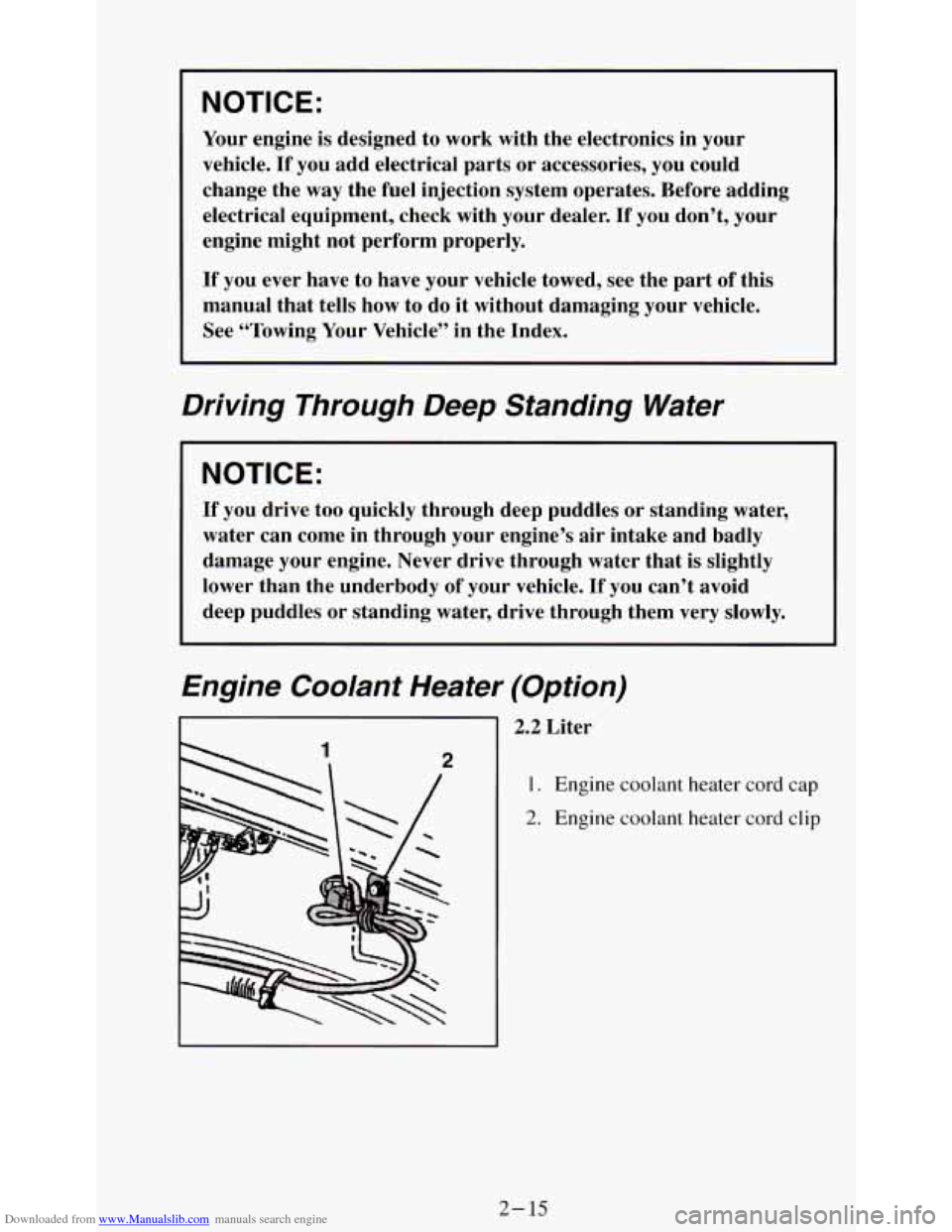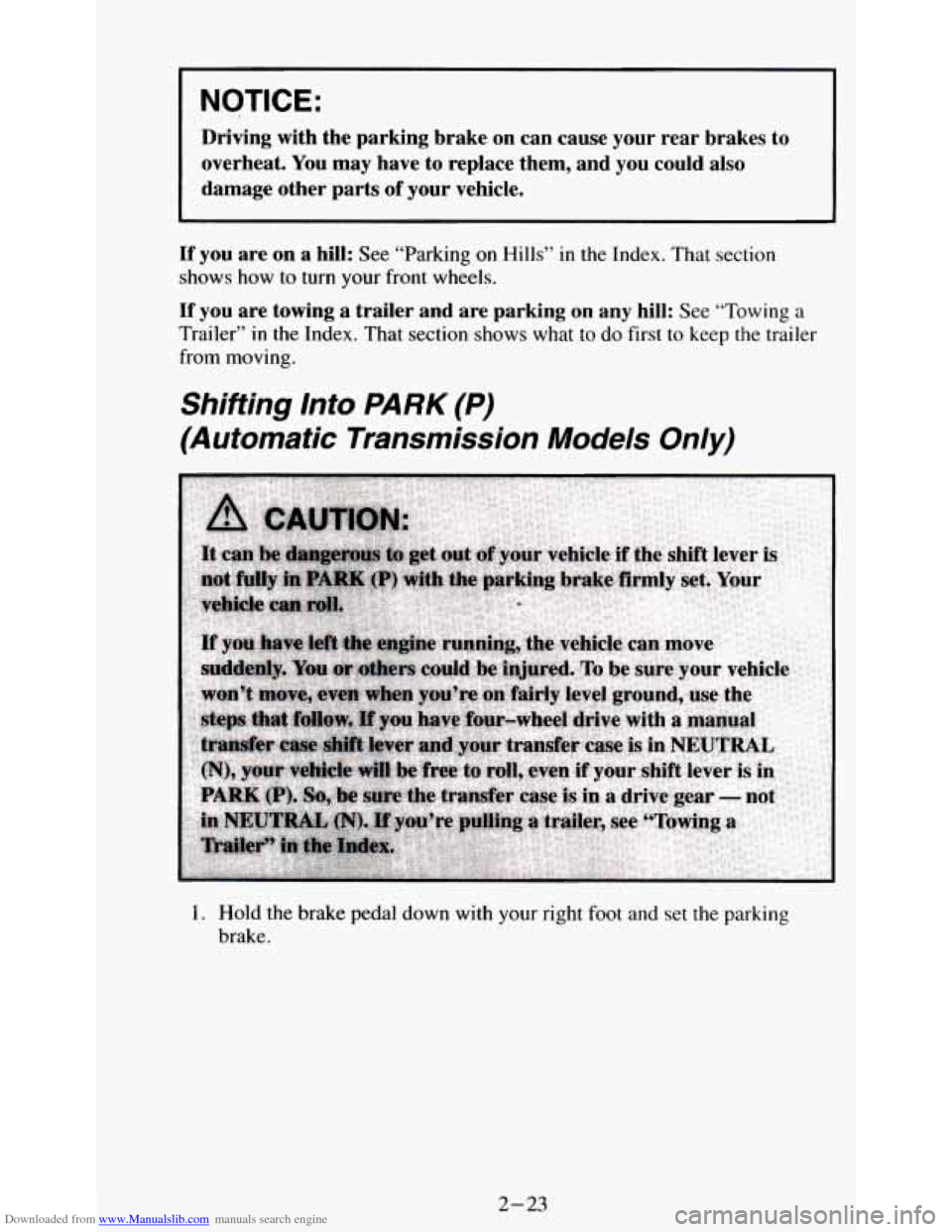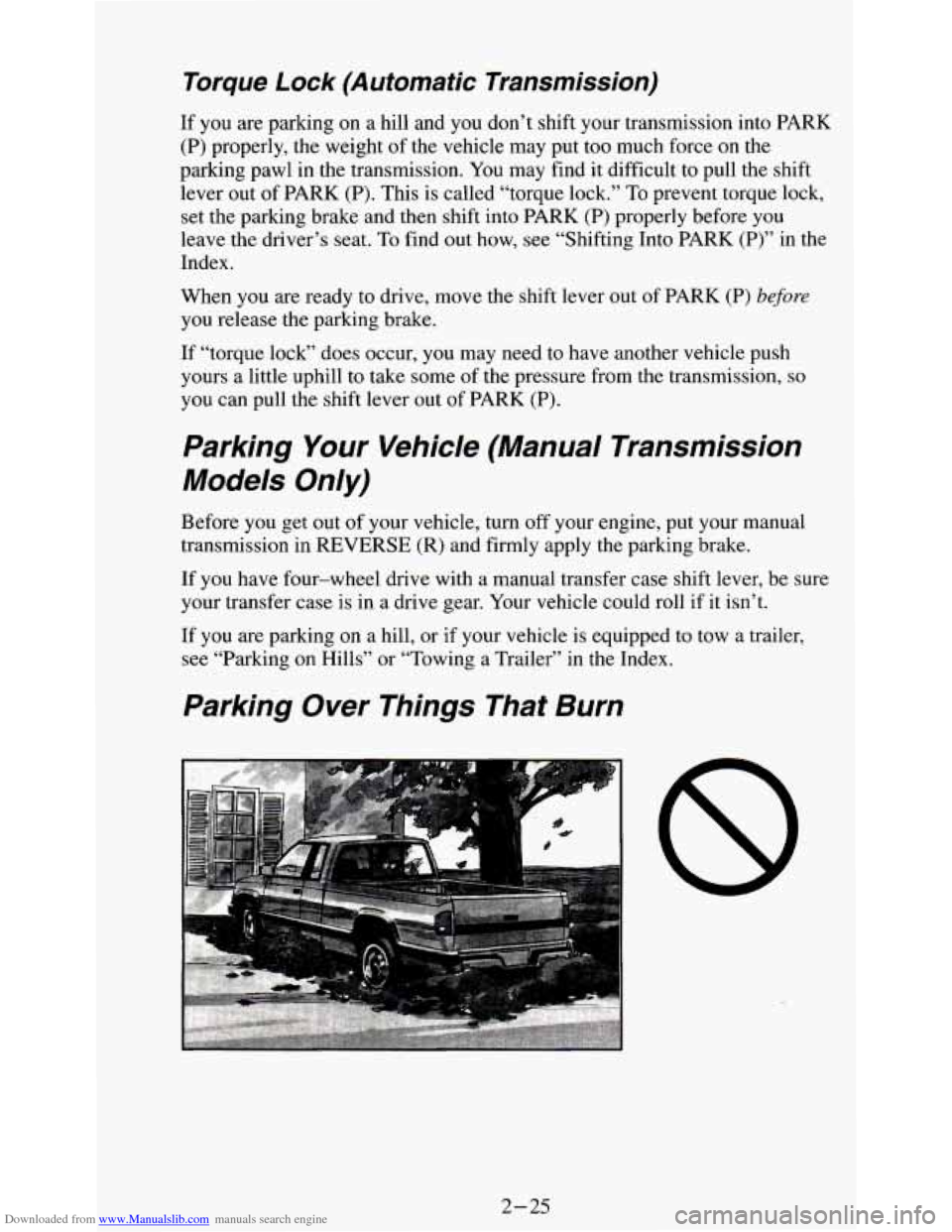1995 CHEVROLET S10 towing
[x] Cancel search: towingPage 54 of 354

Downloaded from www.Manualslib.com manuals search engine Parking at Nlght
Park in a lighted spot, close all windows and lock your vehicle. Remember
to keep your valuables out
of sight. Put them in a storage area, or take them
with you.
Parking Lots
If you park in a lot where someone will be watching your vehicle, it’s best
to lock
it up and take your keys. But what if you have to leave your ignition
key? What
if you have to leave something valuable in your vehicle?
Put your valuables in a storage area, like your glove box.
Lock all the doors except the driver’s.
New Vehicle “Break-In”
NOTICE:
Your modern vehicle doesn’t need an elaborate “break-in.” But
it will perform better in the long run if you follow these
guidelines:
0 Keep your speed at 55 mph (88 km/h) or less for the first 500
miles (804 km).
Don’t drive at any one speed - fast or slow - for the first
500 miles (804 km). Don’t make full-throttle starts.
Avoid making hard stops for the first 200 miles (322 km) or
so. During this time your new brake linings aren’t yet broken
in. Hard stops with new linings can mean premature wear and
earlier replacement. Follow this “breaking-in” guideline
every time you get new brake linings.
Don’t tow a trailer during “break-in.” See “Towing a Trailer”
in the Index for more information.
2-9
Page 58 of 354

Downloaded from www.Manualslib.com manuals search engine 2. If your engine still won’t start (or starts but then stops), it could be
flooded with too much gasoline. Try pushing your accelerator pedal all
the way to the floor and holding it there as you hold the key in START
again, do the same thing, but this time keep the pedal down for five or
six seconds. This clears the extra gasoline from the engine.
’ for about three seconds. If the vehicle starts briefly but then stops
NOTICE:
Your engine is designed to work with the electronics in your
vehicle.
If you add electrical parts or accessories, you could
change the way the fuel injection system operates. Before adding
electrical equipment, check with your dealer.
If you don’t, your
engine might not perform properly.
If you ever have to have your vehicle towed, see the part of this
manual that tells how
to do it without damaging your vehicle.
See “Towing Your Vehicle” in the Index.
To start your 4.3 Liter Code Z engine:
1. Without pushing the accelerator pedal, turn your ignition key to
START. When the engine starts, let go of the key. The idle speed will
go down as your engine gets warm.
NOTICE:
Holding your key in START for longer than 15 seconds at a time
will cause your battery to be drained much sooner. And the
excessive heat can damage your starter motor.
2. If it doesn’t start right away, hold your key in START. If it doesn’t start
in three seconds, push the accelerator pedal about one-quarter of the
way down for 12 more seconds, or until it starts.
3. If your engine still won’t start (or starts but then stops), it could be
flooded with too much gasoline. Try this:
4. Wait 15 seconds to let the starter motor cool down. Then push your
accelerator pedal all the way to the floor. Hold
it there. Then, hold the
key in
START for no more than ten seconds. This clears the extra
gasoline from the engine.
If the engine still doesn’t start, wait another 15 seconds and do Step 4
again.
When the engine starts, let go
of the key and the accelerator pedal.
2-
13
Page 59 of 354

Downloaded from www.Manualslib.com manuals search engine NOTICE:
Your engine is designed to work with the electronics in your
vehicle.
If you add electrical parts or accessories, you could
change the way the fuel injection system operates. Before adding
electrical equipment, check with your dealer.
If you don’t, your
engine might not perform properly.
If you ever have to have your vehicle towed, see the part of this
manual that tells how to do it without damaging your vehicle.
See “Towing Your Vehicle” in the Index.
To start your 4.3 Liter Code W engine:
1. Without pushing the accelerator pedal, turn your ignition key to
START. When the engine starts, let go of the key. The idle speed will
go down as your engine gets warm.
NOTICE:
Holding your key in START for longer than 15 seconds at a time
will cause your battery to be drained much sooner. And the
excessive heat can damage your starter motor.
2. If it doesn’t start right away, hold your key in START. If it doesn’t start
in 10 seconds, push the accelerator pedal all the way down for 5
seconds, or until it starts.
3. If your engine still won’t start, wait 15 seconds to let the starter motor
cool down and do it all again.
When the engine starts, let go
of the key and the accelerator pedal.
Page 60 of 354

Downloaded from www.Manualslib.com manuals search engine NOTICE:
Your engine is designed to work with the electronics in your
vehicle.
If you add electrical parts or accessories, you could
change the way the fuel injection system operates. Before adding
electrical equipment, check with your dealer. If you don’t, your
engine might not perform properly.
If you ever have to have your vehicle towed, see the part of this
manual that tells how to do it without damaging
your vehicle.
See “Towing Your Vehicle” in the Index.
Driving Through Deep Standing Water
1 NOTICE:
If you drive too quickly through deep puddles or standing water,
water can come in through your engine’s air intake and badly
damage your engine. Never drive through water that is slightly
lower than the underbody of your vehicle.
If you can’t avoid
deep puddles or standing water, drive through them very slowly.
Engine Coo/ant Heater (Option)
2.2 Liter
1. Engine coolant heater cord cap
2. Engine coolant heater cord clip
2- 15
Page 63 of 354

Downloaded from www.Manualslib.com manuals search engine A CAUTION:
It is dangerous to get out of your vehicle if the shift lever is not
fully in
PARK (P) with the parking brake firmly set, Your
vehicle can roll.
Don’t leave your vehicle when the engine
is running unless you
have to.
If you have left the engine running, the vehicle can move
suddenly.
You or others could be injured. To be sure your vehicle
won’t move, even when you’re on
fairly level ground, always set
your parking brake and move the shift lever to
PARK (P),
If you have four-wheel drive, your vehicle will be free to roll -
even if your shift lever is in PARK (P) - if your transfer case is
in NEUTRAL (N). So, be sure the transfer case is in a drive gear,
two-wheel high (2HI) or four-wheel high (4HI) or four-wheel
low
(4LO) - not in NEUTRAL (N). See “Shifting Into PARK
(P)” in the Index. If you’re pulling a trailer, see “Towing a
Trailer” in the Index.
REVERSE (R) - Use this gear to back up.
NOTICE:
Shifting to REVERSE (R) while your vehicle is moving forward
could damage your transmission. Shift
to REVERSE (R) only
after your vehicle is stopped.
To rock your vehicle back and forth to get out of snow, ice or sand
without damaging your transmission,
see “If You’re Stuck: In Sand,
Mud, Ice or
Snow” in the Index.
0 NEUTRAL (N) - In this position, your engine doesn’t connect with
the wheels.
To restart when you’re already moving, use NEUTRAL (N)
only. Also, use NEUTRAL (N) when your vehicle is being towed.
2- 18
Page 64 of 354

Downloaded from www.Manualslib.com manuals search engine NOTICE:
Damage to your transmission caused by shifting out of PARK
(P) or NEUTRAL (N) with the engine racing isn’t covered by
your warranty.
0 OVERDRIVE (@) - This position is for normal driving. If you need
more power for passing, and you’re:
- Going less than about 35 mph (56 kdh), push your accelerator
pedal about halfway down.
- Going about 35 mph (56 kdh) or more, push the accelerator all
the way down.
You’ll shift down to the next gear and have more power.
OVERDRIVE
(a) should not be used when towing a trailer,
carrying
a heavy load, driving on steep hills, or for off-road
driving. Select DRIVE
(D) when operating the vehicle under any
of these conditions.
DRIVE (D) - This is like @, but you never go into Overdrive. You
should use DRIVE
(D) when towing a trailer, carrying a heavy load,
driving on steep hills, or for off-road driving.
0 SECOND GEAR (2) - This position gives you more power but lower
fuel economy. You can use SECOND GEAR (2) on hills. It can help
control your speed
as you go down steep mountain roads, but then you
would
also want to use your brakes off and on.
If you manually select SECOND GEAR (2), the transmission will drive
in second gear. You may use this feature for reducing torque to the rear
wheels when
you are trying to start your vehicle from a stop on
slippery road surfaces.
2- 19
Page 68 of 354

Downloaded from www.Manualslib.com manuals search engine NOTICE:
Driving with the parking brake on can cause your rear brakes to
overheat. You may have to replace them, and you could also
damage other parts
of your vehicle.
If you are on a hill: See “Parking on Hills” in the Index. That section
shows how to
turn your front wheels.
If you are towing a trailer and are parking on any hill: See “Towing a
Trailer” in the Index. That section shows what to do first to keep the trailer
from moving.
Shifting Into PARK (P)
(Automatic Transmission Models Only)
1. Hold the brake pedal down with your right foot and set the parking
brake.
2-23
Page 70 of 354

Downloaded from www.Manualslib.com manuals search engine Torque Lock (Automatic Transmission)
If you are parking on a hill and you don’t shift your transmission into PARK
(P) properly, the weight of the vehicle may put too much force on the
parking pawl in the transmission. You may find it difficult
to pull the shift
lever out
of PARK (P). This is called “torque lock.” To prevent torque lock,
set the parking brake and then shift into PARK (P) properly before you
leave the driver’s seat.
To find out how, see “Shifting Into PARK (P)” in the
Index.
When you
are ready to drive, move the shift lever out of PARK (P) before
you release the parking brake.
If “torque lock” does occur, you may need
to have another vehicle push
yours a little uphill
to take some of the pressure from the transmission, so
you can pull the shift lever out of PARK (P).
Parkirig Your Vehicle (Manual Transmission
Models Only)
Before you get out of your vehicle, turn off your engine, put your manual
transmission in REVERSE
(R) and firmly apply the parking brake.
If you have four-wheel drive with a manual transfer case shift lever, be sure
your transfer case is in a drive gear. Your vehicle could roll if it isn’t.
If
you are parking on a hill, or if your vehicle is equipped to tow a trailer,
see “Parking on Hills”
or “Towing a Trailer” in the Index.
Parking Over Things That Burn
A
8
2-25